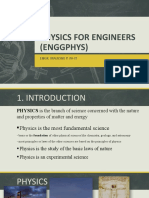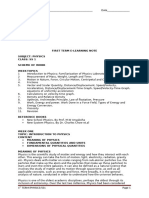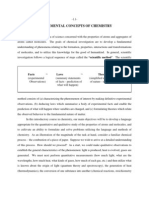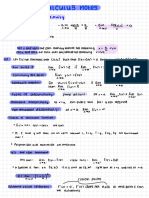Lecture Notes 1 - Introduction, Physical Quantities
Uploaded by
JezManuel04Lecture Notes 1 - Introduction, Physical Quantities
Uploaded by
JezManuel04INTRODUCTION
The objectives of this chapter are as follows
1. articulate the vision, mission, goals and objectives of BSU
2. relate the school’s VMGO to the course objectives
3. comprehend with clarity the course requirements, class rules, guidelines and applying
them while enrolled in the class.
4. Identify and describe the five great theories in Physics
5. Differentiate law from a theory.
6. Explain the importance of studying physics and its relation to other fields.
7. Demonstrate a positive attitude towards Physics while recognizing its limitations
1.1. Nature of Physics
Physics is the discipline of science most directly concerned with the fundamental laws of
nature. These laws explain the why’s of what we see in nature. Other areas in science and
various branches of engineering are built on the basic laws that make up the subject matter
of physics.
1.2. Five Great Theories of Physics
Physics is a set of general theories, each of which describes a wide range of phenomena
and objects. This is divided into five theories:
1. Mechanics (sometimes called Newtonian mechanics or classical mechanics)
- the theory of motion of material objects.
2. Thermodynamics
- the theory of heat, temperature, and the behavior of large array of particles.
3. Electromagnetism
- the theory of electricity, magnetism, and electromagnetic radiation.
4. Relativity
- the theory of invariance in nature and the theory of high-speed motion.
5. Quantum Mechanics
- the theory of the mechanical behavior of the submicroscopic world.
1.3. Importance of studying physics
The goal of the physicist is to encompass as much as possible of the behavior of matter
with the simplest possible array of ideas and equations.
The goal of the beginning student of physics must do more than learn facts, laws, equations, and
problem-solving techniques but must seek to grasp the whole of physics, appreciate its generality,
see the interconnections of its parts, and perceive its boundaries; must seek to distinguish between
theory and application, and between general law and specific fact.
PHYSICS FOR ENGINEERS Lecture Module 1
LESSON 2
PHYSICAL QUANTITIES
Objectives:
1. Differentiate a fundamental quantity from derived quantity.
2. Differentiate a scalar from a vector quantity.
3. Convert one measurement from one unit to another.
4. Perform graphical analysis of vectors and vector operations.
5. Demonstrate understanding on the applications of vectors.
2.1 PHYSICAL QUANTITY
A physical quantity is something that can be measured. It has a name, a physical dimension,
and a unit of measurement; it can be manipulated mathematically, and it can be assigned a
numerical or other mathematical value. Example of a physical quantity is mass of an object. If an
object is 20 g, the 20 g describes the magnitude of the quantity, the 20 describes its dimension or
value, while g describes its unit.
2.2 CLASSIFICATION OF PHYSICAL QUANTITIES
Physical quantities may be classified as basic/fundamental or derived. They may also be
scalars or vectors.
A. Fundamental and Derived Quantities
1. A fundamental quantity cannot be “resolved” into other quantities. They are quantities that
are directly measured and have a single unit.
Example I s time. You can directly measure time using a measuring device like a watch
or a clock and I t has a single unit which could be hour, minute or second.
2. Derived quantities result from the combination through division or/and multiplication
operations of two or more fundamental quantities. Most physical quantities are derived.
Example is area. You cannot directly measure area using a measuring device. For
a rectangular surface, we determine the area by first measuring the length and width and
using multiplication, we can determine the area by multiplying the length with the width
(length x width).
B. Scalar and Vector Quantities
1. A scalar quantity is completely defined by a magnitude (a value and a unit). It is
represented by a single number.
Example is mass. Mass is defined in terms of magnitude only like a mass of 50 kg.
2. Vector quantities are defined by both magnitude and direction. They can be represented
by a directed line segment: an arrow whose length, in any convenient unit, is the
magnitude of the vector, and whose direction is the direction of the vector.
Example of this is displacement. We define displacement in terms of magnitude and
direction like the displacement of 50 m due South.
PHYSICS FOR ENGINEERS Lecture Module 2
2.3. SYSTEMS OF MEASUREMENT
Measurement is essentially a comparison between a known or standard quantity and an
unknown quantity. In other words, every measurement is a comparison. The result of every
measurement has two parts. One is a number to answer the question “How many?” The other is a
unit to answer the question “Of what?”
SYSTEMS OF MEASUREMENT: There are three standard sets of measurements or units. They
are the international system, or SI (often called the MKS system), the Gaussian or CGS system and
the English system or FPS. The table below shows the unit of the physical quantities length, mass
and time with their corresponding units under the three systems of measurement.
The Basic Quantities and their Units
UNITS
QUANTITY SI CGS FPS
Length Meter, m Centimeter, cm Foot, ft
Mass Kilogram, kg Gram, g Slug
Time Second, s Second, s Second, s
For the SI or MKS system, the units of length, mass and time are respectively meter, kilogram
and second. Under the CGS system, centimeter, gram and second are the corresponding units of
length, mass and time. The units foot, slug and second are likewise the corresponding units under
the FPS system.
CONVERSION OF UNITS
In solving problems involving physical quantities, the units should be consistent where all units
should be under one system of measurement. When a given quantity does not have the prescribed
unit under a system used, conversion of unit should be done.
Two Rules applied to conversion of units:
1) Units are treated in an equation in exactly the same way as algebraic quantities, and may
be multiplied and divided by one another;
2) Multiplying or dividing a quantity by 1 does not affect its value.
Listed below are some conversion factors used:
Time: 1 hour = 60 min = 3600 s
1 day = 1440 min = 8.64 x 104 s
1 year = 365.2 days = 3.156 x 107 s
Length:
1 meter (m) = 100 cm = 1000 mm = 39.37 in. = 3.281 ft
1 cm = 10 mm = 0.3937 in.
1 km = 1000 m = 0.6214 mi
1 foot (ft) = 12 in. = 0.3048 m = 30.48 cm
1 inch (in.) = 2.54 cm
1 mile (mi) = 5280 ft = 1.609 km
1 nautical mile (nmi) = 6076 ft = 1.152 mi = 1.852 km
1 light year = 9.461 x 1015 m
Mass:
1 kilogram (kg) = 1000 grams (g) 1 g = 6.58 x 10-5 slug
1 slug = 14.59 kg 1 atomic mass unit (amu) = 1.660 x 10-27 kg
PHYSICS FOR ENGINEERS Lecture Module 3
Volume:
1 m3 = 103 liters (l) = 1 x 106 cm3 = 35.32 ft3
1 liter (l) = 1000 ml = 103 cm3
1 ml = 1 cubic centimeter (cm3)
1 ft3 = 28.32 liters = 7.481 gallons
Force:
1 newton (N) = 105 dyne = 0.2248 lb
1 lb =4.448 N = 4.448 x 105 dyne
Pressure:
1 pascal (Pa) = 1 N/m2 1 bar = 105 Pa = 14.5 lb/in2
1 lb/in2 = 6.895 x 103 Pa 1 atm = 1.013 x 105 Pa =1.013 bar = 14.70 lb/in.2
Energy:
1 joule (J) = 107 ergs = 0.239 cal =2.39 x 10-4 kcal = 0.7376 ft . lb
1 cal = 4.186 J
1 kcal = 4185 J = 3077 ft . lb
1 Btu = 1054 J = 252 cal = 778 ft . lb
1 kWh = 3.6 x 106 J = 2.655 x 106 ft-lb = 860.4 kcal
Angle:
1 radian (rad) = 57.30o = 180o/ p 1o = 0.01745 rad = p / 180o
o
1 revolution (rev) = 360
Example:
Convert 30 kg/m3 to g/cm3
Solution:
To convert a given quantity to a prescribed unit the following should be considered:
- the two rules on conversion should be used.
- The conversion factors to be used would be written in fraction formed.
Example: The conversion factor 1 kWh = 3.6 x 106 J could be written in fraction formed
as follows:
(1 kWh / 3.6 x 106 J) or (3.6 x 106 J/ 1 kW)
*The fraction to be used would be based on which one can eliminate one unit and
convert it to another unit by division and/or multiplication).
To solve the problem, first, the given variable is equated to the same variable
30 kg/m3 = 30 kg
m3
The units to be converted are kg/m3 to g/cm3 but does not have a corresponding direct
conversion factor from kg/m3 to g/cm3. If this is the case, conversion would be done one unit
at a time. There are two units to be converted: kg to g, and m3 to cm3. Using the corresponding
conversion factor for each and choosing the right fractioned form to eliminate, through
division, the given unit to the prescribed unit
1 kg = 1000 g and 1 m = 100cm to
1000g/1kg and 1m /100cm
This would give us
30 kg/m3 =30 kg (1000g) [(1 m ) ] 3 = 30(1000) .
3 3 3
m (1 kg) [(100cm)] 1(100)
= 30(1000) .
1(100)(100)(100)
= 0.03 g/cm 3
PHYSICS FOR ENGINEERS Lecture Module 4
You might also like
- Lesson Note On Physics SS1 First Term - EdudelighNo ratings yetLesson Note On Physics SS1 First Term - Edudeligh76 pages
- PW 01 - 25.02-1.03.2019 - Physical Quantities and Error Calculations PDFNo ratings yetPW 01 - 25.02-1.03.2019 - Physical Quantities and Error Calculations PDF53 pages
- Phy 107 Alternative to Practical ManualNo ratings yetPhy 107 Alternative to Practical Manual23 pages
- PHY 17 - College Physics I Chapter I-Introduction To PhysicsNo ratings yetPHY 17 - College Physics I Chapter I-Introduction To Physics4 pages
- GENERAL PHYSICS I Introduction,units,vectors_023856No ratings yetGENERAL PHYSICS I Introduction,units,vectors_0238567 pages
- Units and Measurement Class 11 Notes Physics Chapter 2No ratings yetUnits and Measurement Class 11 Notes Physics Chapter 211 pages
- PHYSICS STUDY GUIDE 4th Year 1 Term 2021No ratings yetPHYSICS STUDY GUIDE 4th Year 1 Term 20212 pages
- College of Engineering and Computer Science Mechanical Engineering Department Mechanical Engineering 390 Fluid MechanicsNo ratings yetCollege of Engineering and Computer Science Mechanical Engineering Department Mechanical Engineering 390 Fluid Mechanics5 pages
- You Want To Compare The Present Value of $1000 Yearly For 13 Years With $10 000 Now. So You Want To Calculate The Present Value of An AnnuityNo ratings yetYou Want To Compare The Present Value of $1000 Yearly For 13 Years With $10 000 Now. So You Want To Calculate The Present Value of An Annuity5 pages
- TB_Unit4ProgressCheckFRQPartA_673ade3abd7f21.673ade3bb26c41.15425034 (3)No ratings yetTB_Unit4ProgressCheckFRQPartA_673ade3abd7f21.673ade3bb26c41.15425034 (3)1 page
- RN4 - BEEA StatPro RN - Sampling and Sampling Distribution of The Sample Mean - SJ - JC - FINALNo ratings yetRN4 - BEEA StatPro RN - Sampling and Sampling Distribution of The Sample Mean - SJ - JC - FINAL18 pages
- Httpsemas2.Ui - Ac.idpluginfile - Php2375826mod Resourcecontent1kuliah1 2 PDFNo ratings yetHttpsemas2.Ui - Ac.idpluginfile - Php2375826mod Resourcecontent1kuliah1 2 PDF31 pages
- Get Early Childhood Mathematics 2. Ed Edition Sperry Smith PDF Ebook With Full Chapters Now100% (8)Get Early Childhood Mathematics 2. Ed Edition Sperry Smith PDF Ebook With Full Chapters Now70 pages
- Aops Community 1976 Amc 12/ahsme: N N 1 N N 1No ratings yetAops Community 1976 Amc 12/ahsme: N N 1 N N 17 pages
- Maths Class Xii Sample Paper Test 01 For Board Exam 2024No ratings yetMaths Class Xii Sample Paper Test 01 For Board Exam 20245 pages
- Course Instructors: Dr. Victor T. Odumuyiwa Dr. Ufuoma C. Ogude Department of Computer Sciences University of LagosNo ratings yetCourse Instructors: Dr. Victor T. Odumuyiwa Dr. Ufuoma C. Ogude Department of Computer Sciences University of Lagos22 pages
- PW 01 - 25.02-1.03.2019 - Physical Quantities and Error Calculations PDFPW 01 - 25.02-1.03.2019 - Physical Quantities and Error Calculations PDF
- PHY 17 - College Physics I Chapter I-Introduction To PhysicsPHY 17 - College Physics I Chapter I-Introduction To Physics
- GENERAL PHYSICS I Introduction,units,vectors_023856GENERAL PHYSICS I Introduction,units,vectors_023856
- Units and Measurement Class 11 Notes Physics Chapter 2Units and Measurement Class 11 Notes Physics Chapter 2
- College of Engineering and Computer Science Mechanical Engineering Department Mechanical Engineering 390 Fluid MechanicsCollege of Engineering and Computer Science Mechanical Engineering Department Mechanical Engineering 390 Fluid Mechanics
- You Want To Compare The Present Value of $1000 Yearly For 13 Years With $10 000 Now. So You Want To Calculate The Present Value of An AnnuityYou Want To Compare The Present Value of $1000 Yearly For 13 Years With $10 000 Now. So You Want To Calculate The Present Value of An Annuity
- TB_Unit4ProgressCheckFRQPartA_673ade3abd7f21.673ade3bb26c41.15425034 (3)TB_Unit4ProgressCheckFRQPartA_673ade3abd7f21.673ade3bb26c41.15425034 (3)
- RN4 - BEEA StatPro RN - Sampling and Sampling Distribution of The Sample Mean - SJ - JC - FINALRN4 - BEEA StatPro RN - Sampling and Sampling Distribution of The Sample Mean - SJ - JC - FINAL
- Httpsemas2.Ui - Ac.idpluginfile - Php2375826mod Resourcecontent1kuliah1 2 PDFHttpsemas2.Ui - Ac.idpluginfile - Php2375826mod Resourcecontent1kuliah1 2 PDF
- Get Early Childhood Mathematics 2. Ed Edition Sperry Smith PDF Ebook With Full Chapters NowGet Early Childhood Mathematics 2. Ed Edition Sperry Smith PDF Ebook With Full Chapters Now
- Maths Class Xii Sample Paper Test 01 For Board Exam 2024Maths Class Xii Sample Paper Test 01 For Board Exam 2024
- Course Instructors: Dr. Victor T. Odumuyiwa Dr. Ufuoma C. Ogude Department of Computer Sciences University of LagosCourse Instructors: Dr. Victor T. Odumuyiwa Dr. Ufuoma C. Ogude Department of Computer Sciences University of Lagos

























































































